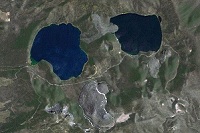newberry_volcano_ crater

Tags
Theme_Keyword: volcano, shield, geology, caldera, pyroclastic flow, lake, obsidian, tephra
Summary
This database was constructed in order to create a geo-referenced digital geologic map of Newberry Volcano to aid in understanding processes and volcano hazards involved in the eruptions of Newberry Volcano.
Description
Newberry Volcano, one of the largest Quaternary volcanoes in the conterminous United States, is a broad shield-shaped volcano measuring 60 km north-south by 30 km east-west with a maximum elevation of more than 2 km. Newberry Volcano is the product of deposits from thousands of eruptions, including at least 25 in the past approximately 12,000 years (Holocene Epoch). Newberry Volcano has erupted as recently as 1,300 years ago, but isotopic ages indicate that the volcano began its growth as early as 0.6 million years ago. Such a long eruptive history and recent activity suggest that Newberry Volcano is likely to erupt in the future. This geologic map database of Newberry Volcano distinguishes rocks and deposits based on their composition, age, and lithology. This geodatabase contains information used to produce the geologic mapping published as Sheet 1 and Sheet 2 in U.S. Geological Survey Miscellaneous Investigations Series Map I-2455 (MacLeod, Sherrod, Chitwood, and Jensen, 1995). The main component of this publication is a geologic map database prepared using geographic information system (GIS) applications. Included are links to files to view or print the map sheets, and the accompanying pamphlet from U.S. Geological Survey Miscellaneous Investigations Series Map I-2455. For the most up-to-date information on the status of U.S. Volcanoes and Current Activity Alerts, please refer to the U.S. Geological Survey Volcano Hazards Program Web site.
Credits
Joseph A. Bard, David W. Ramsey, Norman S. MacLeod, David R. Sherrod, Lawrence A. Chitwood, and Robert A. Jensen
Access and Use Limitations
Uses of this digital geologic map should not violate the spatial resolution of the data. Although the digital form of the data removes the constraint imposed by the scale of a paper map, the detail and accuracy inherent in map scale also are present in the digital data. The fact that this database was edited for a scale of 1:24,000 (Sheet 2) means that higher resolution information is not present in the dataset. Plotting at scales larger than 1:24,000 will not yield greater detail, although it may reveal fine-scale irregularities below the intended resolution of the database. Similarly, where this database is used in combination with other data of higher resolution, the resolution of the combined output will be limited by the lower resolution of these data. Acknowledgment of the U.S. Geological Survey would be appreciated in products derived from these data.